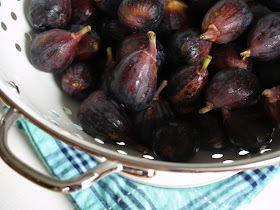I spotted some beautifully ripe black mission figs the other day and knew I needed to make fig jam. I was considering mixing them with strawberries, but ultimately decided to preserve them on their own. I'm glad I did, as there's nothing quite like a 100% unadulterated fig jam. As a child, I used to love Fig Newtons, so I guess this jam fuels that childhood obsession.
This jam isn't too sweet and you can really taste the unique flavor of fresh figs. I quartered the figs instead of dicing them to make it a bit chunky and rustic. It will make an excellent jam to give as gifts come December. The real challenge will be keeping myself from gobbling it up before the holidays!
FRESH FIG JAM
Inspired by Ellie Topp & Margaret Howard, The Complete Book of Small-Batch Preserving
Makes 4 cups, or enough to fill 8 (4-ounce) jelly jars or 4 (8-ounce) half pint jars
Ingredients:
2 pounds fresh black mission figs, stemmed and quartered (about 6 cups quartered figs)
2 cups sugar
Zest from 1 lemon
3 tbsp. freshly squeezed lemon juice (about 1 lemon)
1/4 cup water
A pinch of kosher salt
1/2 teaspoon vanilla extract
Place 1 or 2 small plates in the freezer for testing the jam later on.
Combine the figs, sugar, lemon zest, lemon juice, water, and salt in a large non-reactive pot or Dutch oven. Cover and let stand for 30 minutes to 1 hour, stirring occasionally.
Uncover the pot and bring to a boil over medium-high heat. Reduce the heat to medium and boil rapidly (occasionally mashing the figs with a potato masher to break up the skins), stirring occasionally and scraping the sides and bottom of the pot to prevent scorching, until the jam forms a gel, about 8 to 10 minutes (begin testing the jam to see that it has set after about 8 minutes: remove the pot from the heat and retrieve a plate from the freezer. Place a dollop of jam on the plate and return it to the freezer for a minute. Run your finger through the jam and if it wrinkles slightly, and does not run back together, it's done. If it's still a bit runny, return the pot to the heat and bring to a boil. Continue checking every couple of minutes in the same manner until a gel has formed). Add the vanilla and stir to combine.
Ladle the jam into hot, clean jars, leaving a headspace of 1/4-inch. Remove any air bubbles, wipe rims with a clean paper towel or cloth, and apply lids and rings. Process for 10 minutes in a boiling water-bath canner (for 4 oz. jelly jars or 8 oz. half pint jars). Turn off the heat, remove the lid from the canner, and let the jars sit in the canner for 3 to 5 minutes before removing. Allow the jars to rest on a dishtowel undisturbed for 6 to 8 hours or overnight. Check seals, label, and store in a cool dark place for up to 1 year. If any jars did not seal properly, place them in the fridge and use first. For more detailed information, see my step-by-step guide to canning here.








No comments:
Post a Comment